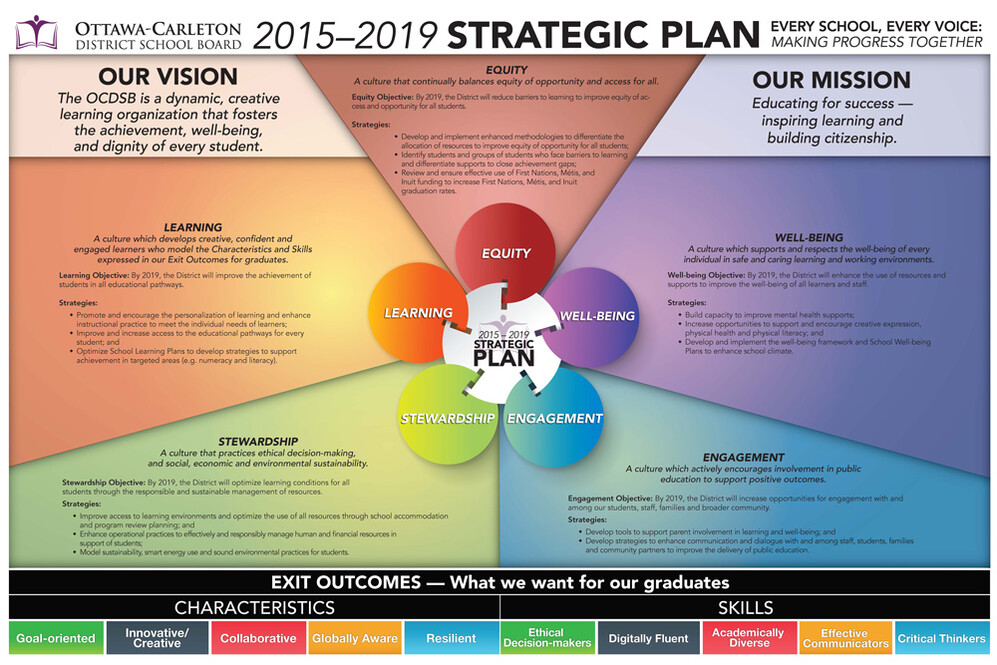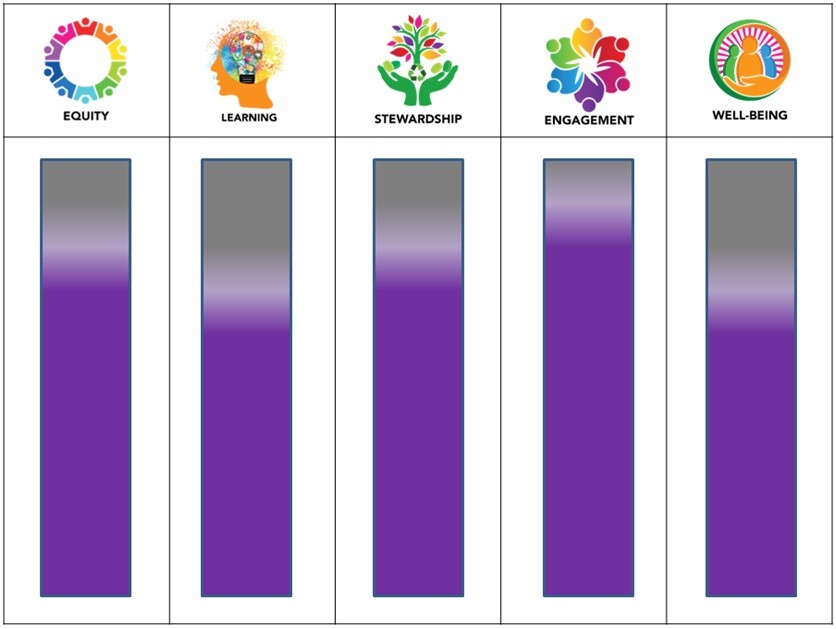The OCDSB’s 2015–2019 Strategic Plan is built on five key strategic priorities – Learning, Well-Being, Equity, Engagement, and Stewardship. These strategic priorities are connected to our Exit Outcomes. The plan includes five objectives and supporting strategies which guide our work. Annually, the Board and the Director of Education develop workplans which identify the key work planned for the school year that will help us to realize our objectives. Each year, the Board of Trustees receives a detailed measurement report on each of the five strategic priorities. These reports provide a detailed qualitative and quantitative analysis of our progress.
Take a look at our current strategic plan or read about it below. The OCDSB is currently working on the development of our next strategic plan. Learn more about our Building Brighter Futures Together process.


Summary of heat map
The heat map provides a snapshot of where we are in terms of progress on each objective. The purple shading indicates progress in that particular area, while the grey depicts work that still needs to be done. While these levels may vary to some degree based on the value placed on the different pieces of evidence, they are informative for big-picture reflection and for identifying opportunities for growth prior to the end of the plan. Considerable progress has been made on each of the five objectives. The heat map identifies that both the learning objective and the well-being objective are the areas where the District still has the most opportunity for progress.
By 2019, the District will reduce barriers to learning to improve equity of access and opportunity for all students.
Strategies & Actions:
‘Develop and implement enhanced methodologies to differentiate the allocation of resources to improve equity of opportunity for all students’
- Updated RAISE index;
- Reviewed school fees;
- Increased efficiencies in school budgets/finances;
- Differentiated staffing;
‘Identify students and groups of students who face barriers to learning and differentiate supports to close achievement gaps’
- Established Black Youth Conference;
- Hosted A Date with Diversity;
- Increased supports for English Language Learners;
- Adopted the UN declaration for People of African Decent;
‘Review and ensure effective use of FNMI funding to increase FNMI graduation rates’
- Began phase-in of grade 11 English course with Indigenous focus;
- Expanded Indigenous Education team;
- Established Indigenous Education Advisory Council;
- Piloted Indigenous STEM.
Evidence of Progress:



Opportunities:
- Formalize methodology for differentiated support for school budgets;
- Provide cultural-proficiency and bias-aware training for all involved in employee selection processes;
- Develop process for the collection and use of identity-based data;
- Implement English Indigenous Education courses and increase the number of sites offering the program.
"A culture that continually balances equity of opportunity and access for all."
Equity Objective:
By 2019, the District will reduce barriers to learning to improve equity of access and opportunity for all students.
Strategies:
- Develop and implement enhanced methodologies to differentiate the allocation of resources to improve equity of opportunity for all students;
- Identify students and groups of students who face barriers to learning and differentiate supports to close achievement gaps;
- Review and ensure effective use of First Nations, Métis, and Inuit funding to increase First Nations, Métis, and Inuit graduation rates.
By 2019, the District will improve the achievement of students in all educational pathways.
Strategies & Actions:
‘Promote and encourage the personalization of learning and enhance instructional practice to meet the individual needs of learners’
- Promoted awareness of the Exit Outcomes, and developed educator resources;
- Implemented a superintendency data support model;
'Improve and increase access to the educational pathways for every student'
- Developed and implemented Elementary & Secondary School Program Frameworks;
- Implemented 50/50 Bilingual Kindergarten;
- Initiated expansion of the International Baccalaureate Program;
- Revised the 7-12 Student Success Model;
- Rolled-out geographic model for special education;
- Implemented changes to the Secondary High Skills Major (SHSM) Program;
- Expanded the Extended Day Program;
- Updated Secondary School Program Delivery;
'Optimize School Learning Plans to develop strategies to support achievement in targeted areas'
- Included math as a target area in all School Learning Plans.
Evidence of Progress:

Opportunities:
- Develop professional learning models in a range of formats;
- Implement Exit Outcomes self-reflection tool;
- Implement revised Student Success Model 7-12;
- Develop and implement framework for business partnerships for SHSM;
- Identify goals aligned with the Focus on Fundamentals of Mathematics in all School Learning Plans;
- Ensure School Learning Plans are posted on school websites.
"A culture which develops creative, confident and engaged learners who model the Characteristics and Skills expressed in our Exit Outcomes for graduates."
Learning Objective:
By 2019, the District will improve the achievement of students in all educational pathways.
Strategies:
- Promote and encourage the personalization of learning and enhance instructional practice to meet the individual needs of learners;
- Improve and increase access to the educational pathways for every student; and
- Optimize School Learning Plans to develop strategies to support achievement in targeted areas (e.g. numeracy and literacy).
By 2019, the District will optimize learning conditions for all students through the responsible and sustainable management of resources
Strategies & Actions:
‘Improve access to learning environments and optimize the use of resources through school accommodation and program review planning’
- Reviewed boundaries and program locations for 29 schools;
- Allowed targeted investments in schools to enhance learning spaces;
- Declared surplus properties;
‘Enhance operational practices to effectively and responsibly manage human and financial resources in support of students’
- Eliminated deficit and balanced budget;
- Invested in learning spaces and school-based supports;
- Provided operational training for principals;
- Developed School Council Funds Management Guide;
- Enhanced process for management of Designated Occasional Teachers;
‘Model sustainability, smart energy use and sound environmental practices forstudents’
- Supported opportunities for students (e.g., Growing Up Organic; Forest School; Nearby Nature; Indoor Garden Pilot; Outdoor Education Centers);
- Reduced carbon emissions.
Evidence of Progress:

Opportunities:
- Initiate boundary review for new Stittsville High School;
- Develop 3-year technology plan;
- Develop and implement succession planning strategies within individual departments and school operations;
- Implement changes to support improved service/ efficiency in EDP/Childcare;
- Collaborate with school councils and principals to improve accountability for school council finances;
- Automate business processes, including forms;
- Examine strategies to support reduction of carbon emissions.
A culture that practices ethical decision-making and social, economic and environmental sustainability.
Stewardship Objective: By 2019, the District will optimize learning conditions for all students through the responsible and sustainable management of resources.
Strategies:
- Improve access to learning environments and optimize the use of all resources through school accommodation and program review planning; and
- Enhance operational practices to effectively and responsibly manage human and financial resources in support of students;
- Model sustainability, smart energy use and sound environmental practices for students.
By 2019, the District will increase opportunities for engagement with and among our students, staff, families, and broader community.
Strategies & Actions:
‘Develop tools to support parent involvement in learning and well-being’
- Renewed District website;
- Renewed all school websites;
- Created and published parent, staff, and student portals;
- Developed an OCDSB app;
- Obtained a license agreement for a platform for interactive engagement;
- Established the Keeping You Connected Newsletter;
‘Develop strategies to enhance communication and dialogue with and among staff, students, families and community partners to improve the delivery of public education’
- Initiated an annual Parent Conference and regular Speaker Series;
- Engaged in professional collaboration with federations;
- Developed and implemented a Complaint Resolution Policy;
- Targeted engagement of at-risk populations;
- Supported initiatives funded through the Ministry of Education’s Parents Reaching Out Grant.
Evidence of Progress:

Opportunities:
- Expand functionality of parent and staff portals;
- Implement revised assessment tools to monitor parent engagement in School Learning Plans;
- Implement orientation program for new Board and Director;
- Undertake consultation and develop new strategic plan.
A culture that practices ethical decision-making and social, economic and environmental sustainability.
Stewardship Objective: By 2019, the District will optimize learning conditions for all students through the responsible and sustainable management of resources. Strategies:
- Improve access to learning environments and optimize the use of all resources through school accommodation and program review planning; and
- Enhance operational practices to effectively and responsibly manage human and financial resources in support of students;
- Model sustainability, smart energy use and sound environmental practices for students.
By 2019, the district will enhance the use of resources and supports to improve the well-being of all learners and staff.
Strategies & Actions:
‘Build capacity to improve mental health supports’
- Designated a District Mental Health Lead;
- Developed and implemented a Mental Health Strategy;
- Provided staff training in the area of mental health;
- Supported student mental health programs (e.g., Sources of Strength; Kids Have Stress Too; Healthy Transitions);
- Conducted Autism Spectrum Disorder Pilots;
‘Increase opportunities to support and encourage creative expression, physical health and physical literacy’
- Implemented Daily Physical Activity;
- Increased funding for after-school sports;
- Targeted funding for the arts;
‘Develop and implement the well-being framework and School Well-Being Plans to enhance school climate’
- Distributed well-being kits and decision-making tool to all principals;
- Supported the development of a well-being goal in School Learning Plans for Student Achievement and Well-being.
Evidence of Progress:

Opportunities:
- Develop OCDSB Mental Health Action Plan, including a focus on self-regulation and Early Years;
- Focus on Teaching Games for Understanding, as part of DPA;
- Promote awareness of concussion management for students and staff;
- Integrate achievement and well-being goals in School Learning Plans;
- Develop awareness and revise policies/ procedures for legalization of cannabis.
A culture which supports and respects the well-being of every individual in safe and caring learning and working environments.
Well-being Objective: By 2019, the District will enhance the use of resources and supports to improve the well-being of all learners and staff.
Strategies:
- Build capacity to improve mental health supports;
- Increase opportunities to support and encourage creative expression, physical health and physical literacy; and
- Develop and implement the well-being framework and School Well-being Plans to enhance school climate.